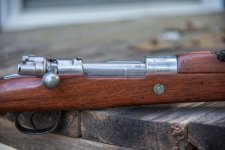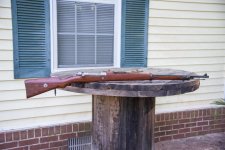Douglas Jr.
Member
BRAZILIAN SMITH & WESSON MODEL 1917 REVOLVER RIG (1942 Pattern)
Dear forum members,
This topic was motivated by a discussion in another thread where it was noticed that most of you never have seen a complete and WWII vintage rig for the Brazilian Smith & Wesson. So, I decided to prepare a short presentation about this material, as it may be helpful to give an insight into the military service of this fantastic sidearm with a minor allied force.
In 1942 Brazilian Army issued the new "Army Personnel Uniforms Regulation" (Regulamento de Uniformes para o Pessoal do Exército), consolidating a field gear that was heavily influenced by the Mills British "Pattern 1937". All the equipment, made of webbing and brass, was made by Brazilian industries using quality materials. All the buttons and buckles were marked "EUB" which stands for "Estados Unidos do Brasil" (United Stated of Brazil, country's official name from 1891 to 1967).
The "basic" rig would comprise the service belt and the holster, both made of light green webbing with brass buckle and press button. A U.S. WWI model lanyard can be added as it was also used (but not often seen).
Well, that was my original idea, and it was supposed to be enough.
The problem is that I found that this type of field gear is, well, highly addictive. And then I decided to go serious: why not get the pouch for the Brazilain 1908 Mauser rifle, the canteen, the Mauser bayonet and frog and the general-purpose bag? I should be satisfied, as it took me more than three years to find all the stuff. And I couldn't resist to get a Brazilian Army marked compass and, sure, the SW manual that was translated directly from the U.S. version to Portuguese for the Brazilian Expeditionary Force in 1944.
However, I was already hooked and I really decided to go wild: why not a vintage tunic? And now what you see here is a WWII-vintage service tunic for a Brazilian 1st Lieutenant (Infantry branch). Troops sent to Italy were issued this uniform, but they were later replaced by other outfits, more suitable to the Italian mountain weather.
This type of field gear was short-lived as the Brazilian participation in WWII as part of the 5th Army, pushed to a modification of this material in order to be interchangeable with the U.S. equipment (with the hook and belt eyelets). So, by the early 1950s most of this material had been discarded or modified to the "North-American" (N.A.) pattern, as it became known in Brazil.
For these pictures I used my two Brazilian 1917s, one of each contract. Finally, I am also providing period pictures showing this uniform and rig in use by Brazilian soldiers.
Hope you enjoy it.
Greetings,
Douglas S. Aguiar Jr.
Firearms Curator
State of São Paulo Police Museum – Brazil
Reproduction of any part of this material (text and/or photos) must be preceded by authorization from the author and with the citation of their authorship. For contact: [email protected]). Don't worry guys, I do not charge any royalties, but I really like to see the credits where credits are due. So, just drop me a message.

Dear forum members,
This topic was motivated by a discussion in another thread where it was noticed that most of you never have seen a complete and WWII vintage rig for the Brazilian Smith & Wesson. So, I decided to prepare a short presentation about this material, as it may be helpful to give an insight into the military service of this fantastic sidearm with a minor allied force.
In 1942 Brazilian Army issued the new "Army Personnel Uniforms Regulation" (Regulamento de Uniformes para o Pessoal do Exército), consolidating a field gear that was heavily influenced by the Mills British "Pattern 1937". All the equipment, made of webbing and brass, was made by Brazilian industries using quality materials. All the buttons and buckles were marked "EUB" which stands for "Estados Unidos do Brasil" (United Stated of Brazil, country's official name from 1891 to 1967).
The "basic" rig would comprise the service belt and the holster, both made of light green webbing with brass buckle and press button. A U.S. WWI model lanyard can be added as it was also used (but not often seen).
Well, that was my original idea, and it was supposed to be enough.
The problem is that I found that this type of field gear is, well, highly addictive. And then I decided to go serious: why not get the pouch for the Brazilain 1908 Mauser rifle, the canteen, the Mauser bayonet and frog and the general-purpose bag? I should be satisfied, as it took me more than three years to find all the stuff. And I couldn't resist to get a Brazilian Army marked compass and, sure, the SW manual that was translated directly from the U.S. version to Portuguese for the Brazilian Expeditionary Force in 1944.
However, I was already hooked and I really decided to go wild: why not a vintage tunic? And now what you see here is a WWII-vintage service tunic for a Brazilian 1st Lieutenant (Infantry branch). Troops sent to Italy were issued this uniform, but they were later replaced by other outfits, more suitable to the Italian mountain weather.
This type of field gear was short-lived as the Brazilian participation in WWII as part of the 5th Army, pushed to a modification of this material in order to be interchangeable with the U.S. equipment (with the hook and belt eyelets). So, by the early 1950s most of this material had been discarded or modified to the "North-American" (N.A.) pattern, as it became known in Brazil.
For these pictures I used my two Brazilian 1917s, one of each contract. Finally, I am also providing period pictures showing this uniform and rig in use by Brazilian soldiers.
Hope you enjoy it.
Greetings,
Douglas S. Aguiar Jr.
Firearms Curator
State of São Paulo Police Museum – Brazil
Reproduction of any part of this material (text and/or photos) must be preceded by authorization from the author and with the citation of their authorship. For contact: [email protected]). Don't worry guys, I do not charge any royalties, but I really like to see the credits where credits are due. So, just drop me a message.























